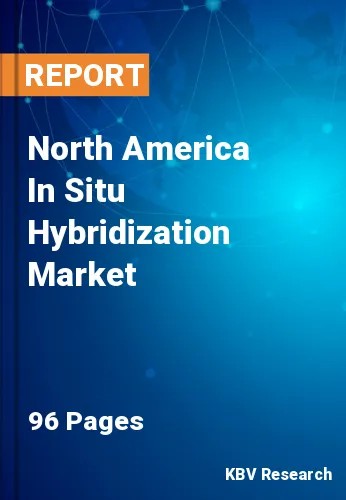The North America In Situ Hybridization Market would witness market growth of 6.3% CAGR during the forecast period (2022-2028).
One of the fundamental techniques in developmental biology is in situ hybridization (ISH), which can enable the visualization and even quantification of therapeutically essential molecules in a morphological context. It is among the most critical methods for observing how genes are expressed at the cellular level in tissues. The first step in comprehending how genes operate is the detection of patterns of gene expression in tissues, which may provide crucial spatial and temporal information.
Nonradioactive probes are preferred over radioactive ones for regular ISH in pathology since the latter require laborious usage. In identifying relatively numerous genes in a single cell, nonisotopic approaches to enhance fluorescence or colorimetric detection offer results with a sensitivity equivalent to that produced by radioactive labeling. In combination with streptavidin-nanogold-silver staining, Super-sensitive ISH may be used to achieve even higher sensitivity when detecting single copies of specific mRNAs. In any instance, the primary determinant of sensitivity is the chosen detection method.
The Canadian government supports groups like the Canadian Partnership Against Cancer in the fight against this illness (CPAC). To continue CPAC's efforts in cancer management, the government has announced intentions to contribute $250 million over five years. With the Canadian Institutes of Health Research, the government is also making large expenditures in cancer research, investing more than $159 million in only 2009–10 to develop therapies and look for a cure. The market for in situ hybridization is anticipated to have considerable expansion in the area over the projected period due to the rising incidence of cancer across North American countries and the rising government funding for the disease's treatment.
The US market dominated the North America In Situ Hybridization Market by Country in 2021, and would continue to be a dominant market till 2028; thereby, achieving a market value of $554.5 million by 2028.The Canada market is poised to grow at a CAGR of 8.7% during (2022 - 2028). Additionally, The Mexico market would witness a CAGR of 7.8% during (2022 - 2028).
Based on Technology, the market is segmented into Fluorescent In Situ Hybridization (FISH) and Chromogenic In Situ Hybridization (CISH). Based on End Use, the market is segmented into Research & Diagnostic Laboratories, Academic Institutes, CROs and Others. Based on Application, the market is segmented into Cancer, Cytogenetics, Developmental Biology, Infectious Diseases and Others. Based on Product, the market is segmented into Instruments, Kits & Probes, Software and Services. Based on Probe, the market is segmented into DNA and RNA. Based on countries, the market is segmented into U.S., Mexico, Canada, and Rest of North America.
Free Valuable Insights: The Global In Situ Hybridization Market is Estimated to reach $1.8 Billion by 2028, at a CAGR of 6.9%
The market research report covers the analysis of key stake holders of the market. Key companies profiled in the report include Thermo Fisher Scientific, Inc., Abbott Laboratories, PerkinElmer, Inc., Agilent Technologies, Inc., Merck Group, Bio-Rad Laboratories, Inc., Bio-Techne Corporation (Advanced Cell Diagnostics, Inc.), Danaher Corporation (Leica Biosystems), F. Hoffmann-La Roche Ltd., and Neogenomics, Inc.
By Technology
By End Use
By Application
By Product
By Probe
By Country
Our team of dedicated experts can provide you with attractive expansion opportunities for your business.

